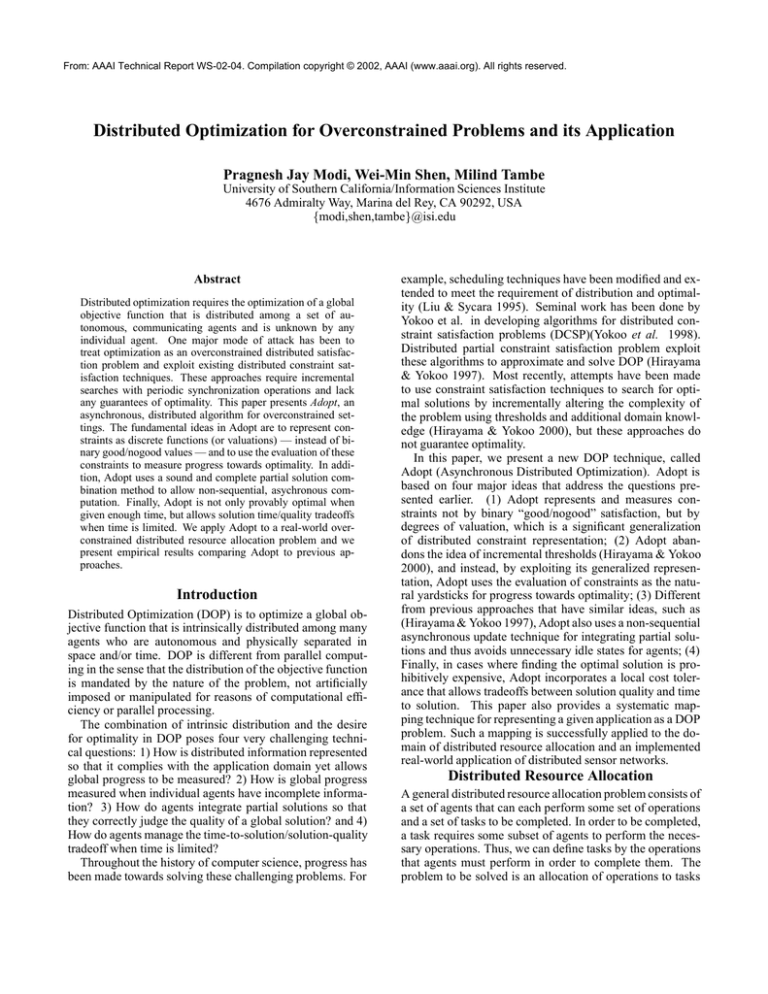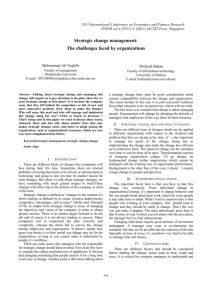
From: AAAI Technical Report WS-02-04. Compilation copyright © 2002, AAAI (www.aaai.org). All rights reserved.
Distributed Optimization for Overconstrained Problems and its Application
Pragnesh Jay Modi, Wei-Min Shen, Milind Tambe
University of Southern California/Information Sciences Institute
4676 Admiralty Way, Marina del Rey, CA 90292, USA
fmodi,shen,tambeg@isi.edu
Abstract
Distributed optimization requires the optimization of a global
objective function that is distributed among a set of autonomous, communicating agents and is unknown by any
individual agent. One major mode of attack has been to
treat optimization as an overconstrained distributed satisfaction problem and exploit existing distributed constraint satisfaction techniques. These approaches require incremental
searches with periodic synchronization operations and lack
any guarantees of optimality. This paper presents Adopt, an
asynchronous, distributed algorithm for overconstrained settings. The fundamental ideas in Adopt are to represent constraints as discrete functions (or valuations) — instead of binary good/nogood values — and to use the evaluation of these
constraints to measure progress towards optimality. In addition, Adopt uses a sound and complete partial solution combination method to allow non-sequential, asychronous computation. Finally, Adopt is not only provably optimal when
given enough time, but allows solution time/quality tradeoffs
when time is limited. We apply Adopt to a real-world overconstrained distributed resource allocation problem and we
present empirical results comparing Adopt to previous approaches.
Introduction
Distributed Optimization (DOP) is to optimize a global objective function that is intrinsically distributed among many
agents who are autonomous and physically separated in
space and/or time. DOP is different from parallel computing in the sense that the distribution of the objective function
is mandated by the nature of the problem, not artificially
imposed or manipulated for reasons of computational efficiency or parallel processing.
The combination of intrinsic distribution and the desire
for optimality in DOP poses four very challenging technical questions: 1) How is distributed information represented
so that it complies with the application domain yet allows
global progress to be measured? 2) How is global progress
measured when individual agents have incomplete information? 3) How do agents integrate partial solutions so that
they correctly judge the quality of a global solution? and 4)
How do agents manage the time-to-solution/solution-quality
tradeoff when time is limited?
Throughout the history of computer science, progress has
been made towards solving these challenging problems. For
example, scheduling techniques have been modified and extended to meet the requirement of distribution and optimality (Liu & Sycara 1995). Seminal work has been done by
Yokoo et al. in developing algorithms for distributed constraint satisfaction problems (DCSP)(Yokoo et al. 1998).
Distributed partial constraint satisfaction problem exploit
these algorithms to approximate and solve DOP (Hirayama
& Yokoo 1997). Most recently, attempts have been made
to use constraint satisfaction techniques to search for optimal solutions by incrementally altering the complexity of
the problem using thresholds and additional domain knowledge (Hirayama & Yokoo 2000), but these approaches do
not guarantee optimality.
In this paper, we present a new DOP technique, called
Adopt (Asynchronous Distributed Optimization). Adopt is
based on four major ideas that address the questions presented earlier. (1) Adopt represents and measures constraints not by binary “good/nogood” satisfaction, but by
degrees of valuation, which is a significant generalization
of distributed constraint representation; (2) Adopt abandons the idea of incremental thresholds (Hirayama & Yokoo
2000), and instead, by exploiting its generalized representation, Adopt uses the evaluation of constraints as the natural yardsticks for progress towards optimality; (3) Different
from previous approaches that have similar ideas, such as
(Hirayama & Yokoo 1997), Adopt also uses a non-sequential
asynchronous update technique for integrating partial solutions and thus avoids unnecessary idle states for agents; (4)
Finally, in cases where finding the optimal solution is prohibitively expensive, Adopt incorporates a local cost tolerance that allows tradeoffs between solution quality and time
to solution. This paper also provides a systematic mapping technique for representing a given application as a DOP
problem. Such a mapping is successfully applied to the domain of distributed resource allocation and an implemented
real-world application of distributed sensor networks.
Distributed Resource Allocation
A general distributed resource allocation problem consists of
a set of agents that can each perform some set of operations
and a set of tasks to be completed. In order to be completed,
a task requires some subset of agents to perform the necessary operations. Thus, we can define tasks by the operations
that agents must perform in order to complete them. The
problem to be solved is an allocation of operations to tasks
such that all tasks are performed. More formally, a Distributed Resource Allocation Problem is a structure <Ag ,
O, T , w > where
Ag is a set of agents, Ag = fA1 , A2 , ..., An g.
O = fO11 ; O21 , ..., Opi , ..., Oqn g is a set of operations, where
operation Opi denotes the p‘th operation of agent Ai . An
agent can only perform one operation at a time.
T is a set of tasks, where a task is a collection of sets
of operations. Let T be a task in T (T power set of
O). tr 2 T is a set of operations called a minimal set
because it represents the minimal resources necessary to
complete the task. There may be alternative minimal sets
that can be used to complete a given task. Minimal sets
from two different tasks conflict if they contain operations
belonging to the same agent.
w: T ! N [ 1 is a weight function that quantifies the
cost of not completing a given task.
A solution to a resource allocation problem involves
choosing minimal sets for tasks such that the chosen minimal sets do not conflict. However, conflict may be unavoidable when there are too many tasks and not enough
resources. In such cases, the agents must allocate resources
only to the most important tasks. More formally, we wish
to find a Tignore T such that T 2Tignore w(T ) is minimized and there are enough agents to complete all tasks in
T n Tignore . We state the complexity of this problem as a
theorem.
Theorem 1: A distributed resource allocation problem
given by <Ag , O, T , w > is NP-Complete.
A concrete instantiation of the above resource allocation
problem is the following distributed sensor network domain.
It consists of multiple fixed sensors, each controlled by
an autonomous agent, and multiple targets moving through
their sensing range. Each sensor is equipped with three radar
heads, each covering 120 degrees. Resource contention may
occure because an agent may activate at most one radar head,
or sector, at a given time. Three sensors must turn on overlapping sectors to accurately track a target. For example in
Figure 1 (left), when agent 1 detects a target in its sector 0,
denoted as operation O01 , it must coordinate with neighboring agents so that they activate their respective sectors that
overlap with agent 1’s sector 0. Targets in a particular region
are tasks that need to be completed/tracked and a choice of
three sensors to track a target corresponds to a minimal set,
e.g. fO01 ; O22 ; O14 g is a minimal set for Target 1.
Figure 1(right) shows a configuration of 9 agents and an
example of resource contention. Since at least three neighboring agents are required to track each target and no agent
can track more than one, only two of the four targets can
be tracked. The agents must find an allocation that minimizes the weight of the ignored targets. In addition, when
the targets are moving quickly and time is limited, we may
be willing to give up optimality for a fast solution.
P
Distributed Optimization Problem
A Distributed Optimization Problem consists of n variables
V = fx1 ; x2 ; :::xn g, each assigned to an agent, where
the values of the variables are taken from finite, discrete
Grid Configuration:
Agent 1
Agent 2
Target 2
Target 3
Target 4
50
Target 2
Agent 4
Agent 3
80
1
2
. .
. .
Target 1
Target 1
O
70
20
Sector Number
Figure 1: Sensor sector schematic(left) and a grid layout
configuration with weighted targets (right)
domains D1 ; D2 ; :::; Dn , respectively. Only the agent who
is assigned a variable has control of its value and knowledge of its domain. The objective is to choose values for
variables such that some criterion function over all possible
assignments is at an extremum. In general optimization
problems, one can imagine any arbitrarily complex criterion
function. In this paper, we restrict ourselves to functions
that can be decomposed into the sum of a set of binary
(and/or unary) functions. Thus, for each pair of variables xi ,
xj , we are given a cost function fij : Di Dj ! N [ 1.
Intuitively, one can think of the cost function as quantifing
the degree to which a particular assignment of values to a
pair of variables is “deficient”, or less than optimal. The
objective is to find a complete assignment A of values to
variables such that the total deficiency is minimized. (An
assignment is complete if all variables in V are assigned
some value.) More formally, let C = fA j A is a complete
assignment of values to variables in V g. We wish to find
A such that A = arg minA2C F (A), where
A
F( ) =
P
xi ;xj
2V
fij (di ; dj )
; where xi = di ;
xj = dj in
A
This change in representation, where constraints have
continuous values, as opposed to binary (satisfied/notsatisfied values), is a major shift from previous approaches
to addressing overconstrained problems. Indeed, ours is a
strict generalization of the standard representation of the
Distributed Constraint Satisfaction Problem from (Yokoo et
al. 1998). For example, a “hard” constraint is modelled as
having infinite cost for all pairs of variable values that violate the constraint and zero cost otherwise.
Solving Resource Allocation Problems
We illustrate a general methodology for mapping the resource allocation problems (e.g., the distributed sensor nets)
into the distributed optimization problem.
S
Variables: 8Tr 2 T ; 8Opi 2 tr 2Tr tr , create a DOP
variable Tr;i . The value of this variable is controlled by
agent Ai .
Domain: For each variable Tr;i , create a value tr;i for
each minimal set in Tr , plus a “I” value (ignore). The
I value does not conflict with any minimal set and thus
when resources are limited, it allows agents to avoid assigning resources to less importance tasks.
We define two constraints on variables (tasks) that specify a
valid allocation of resources. The first constraint prevents
agents from assigning conflicting minimal sets to tasks and
the second requires agents to agree on allocations.
8r; s; i : f (T
; Ts;i ) =
r;i
(1
0
8r; i; j : f (T
r;i
; Tr;j ) =
if the minimal sets
conf lict;
otherwise
(1
0
if Ts ; Tr have
unequal values;
otherwise
Finally, a third constraint requires agents to pay a cost
equal to the weight of the task whenever it is ignored:
8r; i : f (T
(
w(Tr )
r;i ) =
0
if Tr has
value 00 I 00 ;
otherwise
In fact, the first two constraints alone already define a satisfaction problem, but the third one makes it a DOP.
The Adopt Algorithm
Preliminaries
A set of variable/value pairs specifing a (possibly incomplete) assignment is called a view).
Definition: A view is a set of pairs of the form f(xi ,di ),
(xj , dj )...g. A variable can appear in a view no more than
once. Two views are compatible if they do not disagree on
any variable assignment and a view is larger than another
if it contains more variables.
The deficiency of a value of a variable in a view is determined by the sum of its cost functions.
Definition: The local deficiency of a given view vw wrt
variable xi is defined as
Æ (xi ; vw) =
P
xj
2V
fij (di ; dj )
; where xi = di ;
xj = dj in vw
The Adopt algorithm requires variables to have a fixed
tree structured priority ordering. Any such ordering is sufficient and lexicographic ordering is the simplest method.
Figure 3.a shows an example constraint graph and an associated priority order. Two agents with variables xi ; xj are
connected if their cost function fij is not a constant. The
tree ordering can be formed in a preprocessing step, or alternatively, can be discovered during algorithm execution. For
simplicity of description of the algorithm, we will assume
the tree is already formed in a preprocessing step. Figure
3.b shows the search tree formed from the constraint graph
in Figure 3.a.
Adopt
Adopt is a provably optimal, asynchronous distributed optimization algorithm based on four major ideas. First, it
operates on a generalized representation, described in the
previous section, where constraints have degrees of quality (cost) of variable assignment rather than simple binary good/nogood values. Second, Adopt uses the evaluation of these constraints as a solution quality metric and
Initialize: Currentvw
xl Children:
c(xl ; )
0;
V iews(xl )
;
8 2
fg
fg;d
i
null;
fg
hill climb;
when received (VALUE, (xj ; dj ))
add (xj ; dj ) to Currentvw;
hill climb;
when received (VIEW, xl , vw, cost)
add vw to V iews(xl );
c(xl ; vw)
cost;
hill climb;
procedure hill climb
8d 2 Di :
[f
g
e(d)
Æ (xi ; Currentvw
(xi ; d) );
xl Children:
vw
largest view in V iews(xl ) compatible
(xi ; d) );
with Currentvw
e(d)
e(d) + c(xl ; vw);
— (ii)
choose d that minimizes e(d);
if di = d then
di
d;
SEND (VALUE, (xi ; di )) to all connected lower variables;
8 2
[f
g
6
end if;
choose dh where (parent; dh ) 2 Currentvw;
— (iii)
if e(di ) greater than then
SEND (VIEW, xi , Currentvw, e(di )) to
parent;
Figure 2: Procedures from the Adopt algorithm
to measure progress towards the optimal solution. Third,
Adopt performs a distributed branch-and-bound search,
asynchronously combining partial solutions into larger solutions as non-local information is received from other agents.
Finally, in cases where finding the optimal solution is prohibitively expensive, Adopt incorporates a local cost tolerance that allows faster algorithm termination. Adopt’s four
ideas contrast with the leading approach to overconstrained
DCSP (Hirayama & Yokoo 2000). First, they continue to
rely on a satisfaction based approach to value assignment
and thus they use incremental thresholds to progress towards better solutions, which does not guarantee optimality. Also in their approach, complexity is limited by using
thresholding as a global rigid cutoff, i.e. all agents eliminate any constraints that are below the threshold value from
consideration before search begins. This may a priori eliminate constraints that could have been easily satisfied without
backtracking. Finally, the approach in (Hirayama & Yokoo
1997) uses sequential, synchronous searches to build root to
leaf paths which fail to exploit the parallelism in distributed
computation (Hirayama & Yokoo 1997),
Procedures from the Adopt algorithm are shown in Figure
2. xi represents the agent’s local variable and di represents
its current value. The algorithm begins by each agent instantiating its variable concurrently and sending this value
to all its connected lower priority agents via a VALUE mes-
VALUE messages
Connected
A (1)
A (1)
E (2)
F (3)
B (2)
E (2)
B (2)
F (3)
C (3)
VIEW Messages
C (3)
D (4)
(a)
D (4)
(b)
Figure 3: (a) Constraints between agents with priority order
in parentheses. (b) Flow of VALUE and VIEW messages
between agents.
and its ancestors have values fixed to those given in vw.
Lemma 1: An agents estimate of the cost of a solution is
never greater than the actual cost. 8xi 2 V , 8d 2 Di ,
C (x ; Currentvw [ f(x ; d)g)
Lemma 2: Assume Adopt is in a stable state. 8x 2 V , if
e(d)
Algorithm correctness
We show that if Adopt reaches a stable state (all agents are
waiting for incoming messages), then the complete assignment chosen by the agents is equal to the optimal assignment. We first state Lemma 1 which states that an agent
never overestimates cost, and Lemma 2 which says that in a
stable state, an agent’s estimate of cost is equal to the true
cost.
Let C (xi ; vw) denote the local cost at xi plus the cost of
the optimal assignment to descendents of xi , given that xi
i
i
di is xi ’s current value, then,
[ f(x ; d )g)
Theorem 1: Assume Adopt is in a stable state. 8x 2 V ,
if d is the value of x , then (x ; d ) 2 A .
e(di ) = C (xi ; Currentvw
i
i
i
i
sage. After this, agents asynchronously wait for and respond
to incoming messages. Lower priority agents choose values that have the least deficiency given the current values of
higher priority agents stored in the CurrentV iew variable.
This often leads to quick, possibly suboptimal solutions. In
order to escape local minima, lower priority agents report
feedback to higher priority agents. When a lower priority
agent evaluates its local cost functions and realizes the system is incurring cost greater than tolerance level , shown in
Line (iii) of Figure 2, it constructs a VIEW message which
contains its current view of the higher priority agents’ assignments and the associated amount of cost. It sends this
VIEW message only to the lowest higher priority connected
agent (its parent). As an agent receives VIEW messages,
it maintains the set of views and associated costs reported
to it from its children. Then, the agent will either abandon
its current variable value in favor of one with less total cost
(Line (ii)) or pass a VIEW message up to its lowest higher
priority agent. Figure 3.b shows the flow of VALUE and
VIEW messages between agents as the algorithm executes.
An important property of this algorithm is that an agent only
stores variable/value information about connected variables,
rather than building a complete path from root to leaf.
When time is limited, we can increase the value of the
parameter, which in turn allows agents to ignore smaller
costs by not reporting to higher priority agents. This prevents higher priority agents from switching their values, thus
allowing the system to reach a stable state more quickly. A
key property of this local tolerance is that agents still attempt
to find values that minimize costs, as long as it can be done
locally without backtracking. In general, the parameter
would need to be engineered using domain knowledge but
our point is that Adopt is “tune-able” in this way.
i
i
i
i
proof: Lemma 2 states that an agent’s estimate of cost
for its final choice is equal to the minimum cost possible
given what it and higher priority agents have chosen, and
Lemma 1 says that its estimate for the rest of its choices are
a lower bound on the minimum cost for that choice. Each
agent chooses the value that minimizes its estimate given
what higher priority agents have chosen. Clearly, the highest
priority agent chooses optimally and thus by induction, the
entire system chooses optimally. 2
Finally, we have left to show that the algorithm does indeed reach a stable state in which all agents are waiting for
incoming messages. We first state Lemma 3 which states
that an agents estimate of cost never decreases.
Lemma 3: For all d 2 Di , for all xl 2 Children, the
value of c(xl ; vw) is non-decreasing over time.
Theorem 2: Adopt will reach a stable state.
proof: xi sends a VALUE message only in reponse to the
receipt of a VIEW message that changes cost c(xl ; vw). By
Lemma 3, c(xl ; vw) is non-decreasing and by Lemma 1, has
an upper bound. So, eventually c(xl ; vw) must stop changing and xi will stop sending VALUE messages. VIEW messages are only sent to a higher priority agent, and the highest
priority agent never sends VIEW messages. So eventually,
agents will stop sending VIEW messages. Thus, the system
reaches a stable state. 2.
Evaluation
In this section, we present the empirical results from five
experiments using Adopt to solve an overconstrained distributed resource allocation problem in a sensor domain.
These are not toy examples but rather real problems from
hardware sensor configurations similar to that shown in Figure 1(right). To measure progress over time in a system
that is completely asynchoronous and distributed, previous
methods of counting ”synchronous cycles” were not realistic and acceptable. Instead, we measure the number of
search cycles by counting the maximum number of VIEW
messages sent by an agent in the system.
Hypothesis 1: Adopt scales well with increasing number of agents but number of interacting tasks constant.
In terms of the constraint graph, adding more agents corresponds to adding new variables and associated new constraints. However, keeping the number of tasks constant
means that choosing zero-cost assignments for the new constraints is easy. Few cycles should be required between
agents with these types of variables. We experiment with
two configurations, chain and grid, and keep the number of
interacting tasks constant at one, two, three or four. Figure
4 plots the results with number of agents on the x-axis and
number of cycles to optimal solution on the y-axis. We see
that our hypothesis is verified. This means that the number
of agents, by itself, does not adversely affect time to solution. This is a desirable property of our approach since despite a large number of agents (100s), we may sometimes
have only a few interacting tasks.
Hypothesis 2: Adopt scales exponentially as number
of interacting tasks increases. As the number of interacting tasks increases, the constraint graph become harder to
optimize. Thus, a larger number of cycles are necessary to
reach the optimal solution because more search in necessary.
Figure 5 (left) shows results for two sensor configurations.
The chain configuration has 28 variables with domain size
5 and 94 constraints and the grid configuration has 36 variables with domain size 5 and 154 constraints. In both configurations, the variables have a linear (total) priority order.
The graph shows that the number of cycles (y-axis) increases
exponentially as more interacting tasks (x-axis) are added.
Hypothesis 3: Time to solution decreases if priority
ordering of agents reduces the total distance from the
highest to lowest priority agent. To mitigate the exponential increase in time to solution when the number of interacting tasks increases, we minimize the total distance from
the highest to lowest priority agent. We conjecture that if
feedback reaches higher priority agents quicker, perhaps the
exponential increase effect will not be as severe. Figure 5
(right) shows the same two configurations as in Experiment
2, but with a tree-structured (partial) priority order. The results show that a tree structured priority ordering is superior
to a linear ordering in terms of time to solution and thus
supports our hypothesis. How the agents can autonomously
determine the best priority ordering quickly is a potentially
valuable issue for future work.
Hypothesis 4: Increasing tolerance level allows
agents to tradeoff time-to-solution for solution-quality.
We steadily increase and measure the time to solution (cycles) and the quality of solution obtained. Quality of solution is measured as the percentage of best solution possible, so 100% corresponds to the optimal solution. Figure 6
shows the results for four types of configurations. The left
graph shows the number of cycles required to reach a stable
state for each configuration, while the right graph denotes
the quality of the solution obtained for each configuration.
We can see that the parameter allows agents to trade-off
computation time for solution quality. As is increased, the
time to solution falls as the solution quality also degrades.
Only in the most severe cases where is set very high does
Adopt begin to settle upon sub-optimal solutions, and this
drop off is abrupt. This suggests that it is possible to engineer the parameter to obtain high gains in time to solution
without losing much in solution quality. A key surprise was
the non-monotonic decrease in time to solution as is increased in the left graph. This suggests that very small cost
tolerance is actually worse than no tolerance at all.
Hypothesis 5: Adopt is more robust to variance in constraint valuations than incremental thresholding meth-
ods. We are interested in how the valuations of constraints
in the problem effect the performance of different constraint
optimization approaches. Approaches that rely on iterative
thresholds require the constraints to be ordered by their valuation and the way in which the constraints are ordered may
affect the results dramatically.
In order to compare Adopt with satisfaction approaches
that use incremental thresholds, we experiment with two iterative thresholding schemes. In the Removing scheme, a
search for a satisfactory solution is attempted with the entire
problem. If it is found to be unsolvable, constraints below
some threshold are iteratively removed from the problem
until a solvable subproblem is found. The Adding scheme
is the opposite approach beginning with an empty solvable
problem. A crucial point of comparison is the number and
cost of synchronizations required. In the Removing scheme,
if no solution can be found at the current threshold t, agents
must synchronize and somehow decide to drop further constraints at some t + level. Correctly determining this is a
major difficulty of incremental thresholding methods. To be
conservative for these experiments, we assume no synchronization cost and equals one fifth of the highest weighted
constraint. If is set higher, the problem space search becomes very coarse and solution quality is poor. If is too
low, many iterations are required to find a solution and thus
time to solution is adversely affected.
We experiment with three problem classes: equal represents problems in which tasks all have the same weight,
random represents problems in which tasks are randomly
assigned weights in the range [10,100] and in bipolar problems the set of tasks have either weight 10 or 100 and furthermore, if all tasks of weight 10 are ignored, the rest of
the tasks can be performed. Table 1 compares the time to
solution and quality of solution for the three different approaches. We average the results of four different problems in each problem class, so a 100% in the column %opt
means that the algorithm found the optimal solution in all
four problems in the given class, while 0% means the algorithm found no solution for all four problems. The results
show that performance of the two iterative approaches depends heavily on the ordering of the given constraints, while
Adopt is able to perform well over a range of different input
structures.
Finally, Adopt has been used to track actual targets in a
real hardware sensor setup. In the largest scale experiment
to date, 8 sensors/agents were set up in a 60x60 ft area with
two targets moving through the sensing range at approx 1/2
ft/sec. Each hardware sensor was driven by a Pentium PC
and agent communication was done via TCP/IP. Initial results show that agents were able to successfully produce
tracks of targets despite overconstrained situations.
Summary and Related Work
Distributed optimization arises in many domains where information and control is distributed among autonomous
communicating agents. We have presented the Adopt algorithm, a provably optimal asynchronous distributed algorithm for distributed optimization. Adopt represents a new
approach and a departure from previous methods in that it i)
300
One Target,Chain
Two Target,Chain
Three Target,Chain
One Target,Grid
Two Target,Grid
Four Target,Grid
Max Num Cycles to Optimal
250
200
150
100
50
0
4
6
8
10
12
Number of Agents
14
16
Figure 4: Number of cycles with increasing number of
agents and constant number of tasks
Linear Priority Order
Tree Structured Priority Order
1200
1200
References
Chain
Grid
1000
Max Num Cycles to Optimal
Max Num Cycles to Optimal
Chain
Grid
800
600
400
200
1000
800
600
400
200
0
0
1
2
3
4
5
Number of Targets
6
7
1
2
3
4
5
6
Number of Targets
7
8
9
Figure 5: Number of cycles with increasing number of interacting tasks for a linear priority order (left) and tree structured priority order (right)
1200
chain1
chain2
grid1
grid2
1000
chain1
chain2
grid1
grid2
100
800
% Optimal
Max Num Cycles
80
600
60
40
400
20
200
0
0
0
50
100
Tolerance Level (tau)
150
200
0
50
100
Tolerance Level (tau)
150
200
Figure 6: Effect of increasing tolerance level on time to solution(left) and solution quality (right)
Table 1: Adopt ( = 60) vs. Iterative Search
Prob
equal
rand
bipolar
Adopt+
Cycles %Opt
294
87%
70
100%
31
100%
Removing
Cycles %Opt
165
0%
118
83%
41
93%
operates on a valued constraint representation, ii) uses constraint evaluation to measure progress towards the optimal
solution, iii) uses a novel procedure for asynchronously integrating partial solutions into larger solutions, iv) includes
a novel method for trading off solution quality for time to
solution. We show empirical results illustrating Adopts performance on a distributed sensor network resource allocation problem.
Other approaches to distributed optimization include market based systems (Walsh & Wellman 1998), which offer an
promising, alternative path of investigation. We view these
methods as complementary to constraint-based approaches
and hybrid approaches may yield significant advantages over
either alone. Others approaches have used a “coordinator”
agent technique, whereby a special agent collects information about variables and domains from other agents and finds
a solution (Lemaitre & Verfaillie 1997). In many highly distributed domains, this is an infeasible solution.
Adding
Cycles %Opt
37
0%
54
83%
41
93%
Hirayama, K., and Yokoo, M. 1997. Distributed partial constraint
satisfaction problem. In Smolka, G., ed., Principles and Practice
of Constraint Programming – CP97. 222–236.
Hirayama, K., and Yokoo, M. 2000. An approach to overconstrained distributed constraint satisfaction problems: Distributed hierarchical constraint satisfaction. In Proc. of the 4th
Intl. Conf. on Multi-Agent Systems(ICMAS).
Lemaitre, M., and Verfaillie, G. 1997. An incomplete method
for solving distributed valued constraint satisfaction problems. In
Proc. of the AAAI Workshop on Constraints and Agents.
Liu, J., and Sycara, K. 1995. Exploiting problem structure for
distributed constraint optimization. In Proc. of the 1st Intl. Conf.
on Multi-Agent Systems(ICMAS).
Walsh, W., and Wellman, M. 1998. A market protocol for decentralized task allocation. In Proc. of the 3rd Intl. Conf. on MultiAgent Systems(ICMAS).
Yokoo, M.; Durfee, E. H.; Ishida, T.; and Kuwabara, K. 1998. The
distributed constraint satisfaction problem: Formalization and algorithms. IEEE Transactions on Knowledge and Data Engineering 10(5):673–685.





